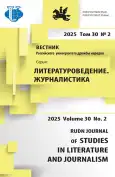Ребенок и семья в романе Р.К. Нараяна «Темная комната»
- Авторы: Сингх С.1, Ренсвигг П Р.1, C П.Д.1
-
Учреждения:
- Институт науки и технологий SRM
- Выпуск: Том 30, № 2 (2025)
- Страницы: 310-320
- Раздел: Литературоведение
- URL: https://journal-vniispk.ru/2312-9220/article/view/319130
- DOI: https://doi.org/10.22363/2312-9220-2025-30-2-310-320
- EDN: https://elibrary.ru/JLIWYV
- ID: 319130
Цитировать
Полный текст
Аннотация
В романе Р.К. Нараяна «Темная комната» дети - Камала, Бабу и Сумати - напрямую влияют на решения Савитри. Несмотря на то что в произведении исследуются темы женского угнетения в патриархальном обществе, именно эмоциональная связь с детьми заставляет главную героиню вернуться домой, отказаться от своего протеста. Через призму детских взаимоотношений раскрывается взгляд Нараяна на структуру семьи, значение традиционных ценностей, связанных с детьми, особенно в отношении родительского авторитета и социальных ожиданий. В результате делаются выводы о специфике мировоззрения писателя, о месте детского мира в контексте принятых социальных норм, месте семьи в жизни общества.
Об авторах
Сундар Сингх
Институт науки и технологий SRM
Email: rencewigg@gmail.com
ORCID iD: 0009-0006-9196-5634
доцент Центра развития карьеры, Управление Центра карьеры
Индия, 603203, Тамил Наду, КаттанкулатурРоланд Ренсвигг П
Институт науки и технологий SRM
Автор, ответственный за переписку.
Email: rencewigg@gmail.com
ORCID iD: 0000-0002-4686-1557
доцент Центра развития карьеры, Управление Центра карьеры
Индия, 603203, Тамил Наду, КаттанкулатурПpeccuлa Дэйзu C
Институт науки и технологий SRM
Email: rencewigg@gmail.com
ORCID iD: 0009-0008-0971-8963
доцент кафедры английского и иностранных языков, Инженерно-технологический колледж
Индия, 603203, Тамил Наду, КаттанкулатурСписок литературы
- Adhikary, R.P. (2020). Existential maturity of Savitri in The Dark Room by R.K. Narayan. UJAH: Unizik Journal of Arts and Humanities, 21(1), 138–155.
- Biswas, A.K. (2022). “Obliged to no man”: Negotiating patriarchy and female subaltern voice in R.K. Narayan’s The Dark Room. RAY: International Journal of Multidisciplinary Studies, 7(1), 6–19.
- Chakladar, A. (2012). Garbo and Kuchela at the Palace Talkies in Malgudi: Women and modernity in R.K. Narayan’s The Dark Room. Studies in the Humanities, 33(1), 113–131. https://doi.org/10.1080/02759527.2012.11932866
- Iyengar, K.R.S. (1983). Indian writing in English (3rd ed.). Sterling Publishers.
- Kabir, K.W. (2020). Toxic masculinity in The Dark Room by R.K. Narayan and Night of No Moon by Syed Waliullah: A comparative study. Educational Research (IJMCER), 2(4), 152–159.
- Kain, G. (2004). R.K. Narayan. In P.P. Piciucco (Ed.), A companion to Indian fiction in English (pp. 1–31). Atlantic Publishers and Distributors.
- Kumari, Y.K. (2017). R.K. Narayan’s The Dark Room: A critical approach. Labyrinth: An International Refereed Journal of Postmodern Studies, 8(1).
- Madhavaiah, G. (2022). Portrayal of women in R.K. Narayan’s The Dark Room. Journal of Positive School Psychology, 6564–6567.
- Mukherjee, M. (1974). The twice born fiction. Arnold-Heinemann Publishers (India) Private Limited. (Original work published 1971.)
- Narayan, R.K. (2003). My days: Autobiography (Reprint of 1974 edition). Indian Thought Publications.
- Narayan, R.K. (2004). The Dark Room (Reprint of 1938 edition). IndianThought Publications.
- Renuka, E. (2000). Three women at the crossroads: Man-woman relationship in R.K. Narayan’s The Dark Room, Mulk Raj Anand’s Gauri, and Renganaya Kamma’s Janaki Vimukthi. The Commonwealth Review, 11(1), 170–174.
- Roy, S., & Mahavidyalaya, D. (2022). Plight and suffering of pre-independent Indian women in R.K. Narayan’s The Dark Room. Creative Flight, 3(2), 102.
- Singh, K. (1982). The ordinary and average as satiric traps: The case of R.K. Narayan. In V.A. Shahane (Ed.), Explorations in modern Indo-English fiction (pp. 131–140). Bahri Publications.
- Singh, S. (2020). R.K. Narayan’s The Dark Room: A study in feminist perspective. Research Review: The Refereed & Peer Review International Journal, 7(91).
- Suganya, S. (2013). To relegate the fringes of marginalized women in the social milieu: A comparative study of R.K. Narayan’s The Dark Room and Anita Nair’s Mistress. International Journal of English Language, Literature, and Humanities, 1(2), 21–32.
- Sundaram, P.S. (1988). R.K. Narayan as a novelist. B. R. Publishing Corporation.
- Trivedi, R., & Soni, M.N. (2014). R.K. Narayan’s The Dark Room: A thematic study. Research Scholar: An International Refereed e-Journal of Literary Explorations, 2(4), 412–417.
- Walsh, W. (1977). Sweet mangoes and malt vinegar: The novels of R.K. Narayan. In K.K. Sharma (Ed.), Indo-English literature: A collection of critical essays (pp. 121–140). Vimal Prakashan.
Дополнительные файлы









